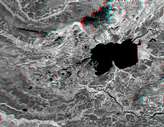
Images & Animations
-
Credit
NASA/JPL/NIMA
The Lake Palanskoye in northern Kamchatka was formed when a large landslide disrupted the drainage pattern, forming a natural dam. The area is volcanically and tectonically active and it is likely that the landslide -- which covers about 80 square kilometers (30 square miles) -- was triggered by an earthquake sometime in the past 10,000 years. The source area of the landslide is the ridge to the upper left of the lake. The steep topographic scar at the head of the slide and the broad expanse of hummocky landslide debris that covers the valley to the left of the lake are visible in 3 D.
This anaglyph was generated by first draping a Landsat Thematic Mapper near-infrared image over a topographic map from the Shuttle Radar Topography Mission, then using the topographic data to create two differing perspectives, one for each eye. When viewed through special glasses, the result is a vertically exaggerated view of the Earth's surface in its full three dimensions. Anaglyph glasses cover the left eye with a red filter and cover the right eye with a blue filter.
Landsat satellites have provided visible light and infrared images of the Earth continuously since 1972. SRTM topographic data match the 30 meter (99 foot) spatial resolution of most Landsat images and will provide a valuable complement for studying the historic and growing Landsat data archive. The Landsat 7 Thematic Mapper image used here was provided to the SRTM project by the United States Geological Survey, Earth Resources Observation Systems (EROS) Data Center, Sioux Falls, South Dakota.
The Shuttle Radar Topography Mission (SRTM), launched on February 11, 2000, used the same radar instrument that comprised the Spaceborne Imaging Radar-C/X-Band Synthetic Aperture Radar (SIR-C/X-SAR) that flew twice on the Space Shuttle Endeavour in 1994. SRTM was designed to collect three-dimensional measurements of the Earth's surface on its 11-day mission. To collect the 3-D data, engineers added a 60-meter-long (200-foot) mast, an additional C-band imaging antenna, and improved tracking and navigation devices. The mission is a cooperative project between the National Aeronautics and Space Administration (NASA), the National Imagery and Mapping Agency (NIMA) and the German (DLR) and Italian (ASI) space agencies. It is managed by NASA's Jet Propulsion Laboratory, Pasadena, CA, for NASA's Earth Science Enterprise, Washington, DC.
Size: 25 by 19 kilometers (16 by 12 miles)
Location: 58.8 deg. North lat., 160.8 deg. East lon.
Orientation: North toward the top
Image Data: Landsat band 4
Original Data Resolution: SRTM and Landsat, 30 meters (99 feet)
Date Acquired: February 12, 2000 (SRTM); August 1, 1999 (Landsat)
Metadata
-
Sensor
Space Shuttle/SRTM -
Visualization Date
2000-02-12

